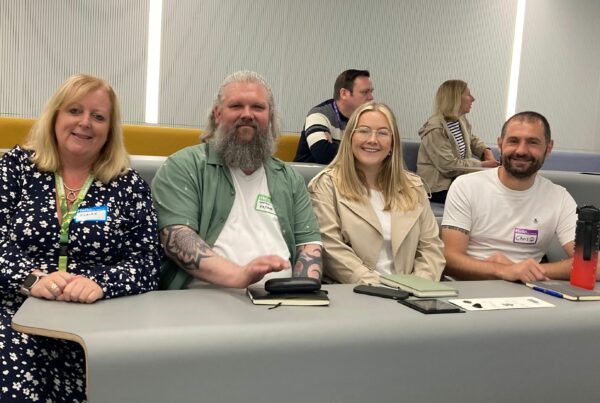International Self-Care Month is from 24th June to 24th July.
While self-care is something to be mindful of every day of the year, this month does provide a good opportunity to consider what self-care actually means and if it’s something we are doing enough of for our own physical and mental wellbeing. It’s also a good time to check in with your employees on this topic and find out if there are ways your business can help your people to prioritise self-care both at work and beyond.
We’ve been talking to Gary Butterfield and Kathryn Lupton about the 5 Ways to Wellbeing Model, self-care and why it’s an important thing for business owners, leaders and managers to consider.
Gary Butterfield is the founder of consultancy, Joy Junction. With 18 years’ experience working in the fitness industry, professional sport, HR, and employee wellbeing, Gary supports organisations to create joyful workplace cultures through wellbeing conversations.
 Firstly Gary, tell us a bit about you: What motivated you to work in the workplace wellbeing space?
Firstly Gary, tell us a bit about you: What motivated you to work in the workplace wellbeing space?
I started my career in the fitness industry after studying sports science at university. It was an industry I’d wanted to work in for a long time.
I joined because I wanted to support people on their wellbeing journeys in whatever way that meant to them. During the same period, I was also fortunate enough to work in professional rugby union with Leeds Carnegie RFU as an intern strength and conditioning coach.
In 2011, after leaving the fitness industry as a full-time employee, I fell into the wonderful world of HR and employee wellbeing at the University of Sheffield. I jumped at the opportunity. No longer was I supporting the journey of 10-15 people…I was now supporting over 8,500 people.
At the University, I co-founded and co-developed their wellbeing strategy, Juice. We won loads of awards along the way, including the Sunday Times Top 100 Wellbeing Award in 2016. Lots of wine was drunk and many good nights had! However, it was what our employees were saying that really mattered.
In 2015, I started working with other large organisations on everything including overarching employee wellbeing strategy, proposition development, and intervention delivery.
What really lights my fire is line manager up-skilling, giving people the competence and confidence to talk about wellbeing with their colleagues. To do this I created a tool called the Conversation Canvas, which is specifically designed to provide a framework using a number of different easy-to-understand academic models.
I love what I do. Together, we can create a joyful workplace culture.
You use the 5 Ways to Wellbeing Model in a lot of your work. Can you tell us a bit more about it and why you think it’s so helpful?
Of all the models that I’ve come across over the years, the New Economics Foundation’s “Five Ways to Wellbeing” is by a long way my favourite.
We’re all aware of the physical, nutritional, mental etc. labels. They’re tried and tested. However, I don’t particularly find them easy to implement.
Let’s take yoga as an example; would you consider this a physical activity because you’re moving your body, or would you consider it a mental activity because it helps you relax? Alternatively, it’s often done with others, so is it a social event? The truth is, yoga is all of these things, and therein lies the problem.
The Five Ways to Wellbeing model is much easier to understand and implement. Whilst there is still some rigidity, between Be Active and Take Notice for example, it allows us a lot more flexibility.
I also think it looks better visually, and have had a lot of fun taking the model and making my own representation of it that fits into my small business’ brand.
How can implementing the 5 Ways to Wellbeing Model help employers create mentally healthy workplaces?
I’ve used the Five Ways to Wellbeing as an internal wellbeing lead, external technology provider, and as a consultant, and I’ve found it incredibly valuable in all cases.
The model gives organisations a set of themes for employee wellbeing that are easier for all parties to understand, implement, and measure. Even if we were to start with just one targeted intervention for each way of wellbeing, we can be confident that our proposition is well-balanced and holistic.
Through the Five Ways to Wellbeing, we can actively encourage the development of social connection, physical activity, gratitude, and learning opportunities; all of which are proven to positively contribute to our mental health.
The Five Ways to Wellbeing model is front and centre on my Conversation Canvas. Working in conjunction with two other models, “Me, We, and Us” and “Maslow’s Hierarchy of Needs”, the model gives line managers a clear framework to have wellbeing authentic and compassionate conversations with their colleagues.
One of the biggest pieces of advice that I would give to an employer would be to look at the Five Ways to Wellbeing in conjunction with the “Me, We, and Us” model. Explore what each way to wellbeing means to your individual employees, teams/departments, and to your organisation. When you have the answer to all three of those stakeholders it’ll be much easier to implement.
Finally, how do you use the 5 Ways to Wellbeing Model in your daily life? Any advice to our network members on how someone can get started implementing positive change using this model as a starting point?
I’m a big fan of simplicity. I’m a simple man. I take each way to wellbeing, reflect on what it means to me, and then implement it as best I can. Questions I’ll regularly ask of myself may include:
• Connect: When was the last time I reached out to someone? How can I reach out to more people to check in, both for their wellbeing and my own?
• Be Active: Where in my diary can I make a commitment to exercise? Do I need to give myself more opportunity?
• Take Notice: What am I grateful for at this moment in my day/life? How does this impact my work?
• Keep Learning: Am I learning and growing? How can I develop myself further?
• Give: Who have I supported recently? How can I support people more?
 Kathryn Lupton (Kate) works as Strategy Lead at NHS England and is a Board Trustee for Leeds Mind. A keen mental health advocate, she is also a Yoga Teacher and Coach.
Kathryn Lupton (Kate) works as Strategy Lead at NHS England and is a Board Trustee for Leeds Mind. A keen mental health advocate, she is also a Yoga Teacher and Coach.
Firstly, tell us a bit about you and your role of Trustee at Leeds Mind
I grew up in Leeds and lived and worked internationally before settling back in the city 10 years ago. I work in a national strategy and leadership role in the NHS, and also as a yoga teacher and career coach (Gen Z, so side hustle needed!). I’m a Mum to two girls and a mental health advocate, with lived experience of supporting a close family member living with severe mental illness. I joined the Leeds Mind Board of Trustees in December 2021.
In the role of Leeds Mind Trustee, you’ve been supporting and providing guidance to the Leeds Mindful Employer Network Project Coordinator. Why do you think having a network like this in the city is important?
It seems like many employers are only just waking up to the fact that they need to do more to support the mental and physical health of their employees. Covid shone a spotlight on this, certainly in the NHS where I work. There’s some amazing work being done across the city, which needs to be shared if we’re all to do better. The network plays a key role in this – giving people a supportive and proactive community to share, learn and connect. I thought the recent bi-annual conference was brilliant – I took away loads of ideas which I hope to take forward in my own NHS organisation!
24th June marks the start of International Self-Care Month, ending on 24th July, with International Self-Care Day. What does the term ‘self-care’ mean to you?
Honestly, I have a bit of a love/hate relationship with the term self-care. I feel like there’s so much pressure on us these days to act a certain way, meet a certain standard. The self-care industry can also feel like this. So for me, self-care is personal – it’s about me understanding myself, where I’m at and what I need to ‘fill my cup’. Sometimes this is a run, sometimes it’s turning off my phone and having a nap!
Why do you think building Self-Care activities into our routine is so important for our mental and physical health and wellbeing?
I’ve found that the small things make the most difference – turning off my phone an hour before bed, saying ‘no’ more, spending time with good friends. As a working parent, I have to work hard to ensure I get the self-care I need. I love the saying “You can’t pour from an empty cup”. Having a routine helps me prioritise this against the busyness of life, as I can tend to put others before myself.
What works for you in terms of self-care? Does your routine vary depending on whether you are in work or recreation mode?
I teach yoga twice a week, walk/run with friends and spend as much time outdoors as I can squeeze in. More and more, I’m trying to build it into my working day – standing up for meetings, walk and talks, getting out at lunch, saying no to unreasonable demands. I used to be rubbish, often going the extra mile at whatever cost. Since having kids and as I approach peri-menopause, it’s something I think more and more about.
Why would you encourage people to make time for self-care in the working day?
I know I work far better when I’ve had regular breaks, done some exercise, connected with colleagues. Many of us spend so much time at work – we need to ensure that we’re taking care of ourselves when we’re there.
What are the different barriers that could prevent people from practicing self-care regularly? How can managers and employers help to promote the importance of prioritising self-care to their managers?
Unrealistic workloads and deadlines, ineffective teamwork, poor role modelling, high demand for travel, there are lots! As a team lead and line manager, it’s important to me that I role model sensible working hours and self-care, including checking in regularly, being trained as a Mental Health First Aider and knowing how to access support. I don’t think I could work in a team where this wasn’t a priority, or I didn’t have support to establish it as one!
What are your top tips for individuals regards finding ways to implement self-care into their daily life?
Make it personal (what did you enjoy doing as a child?), keep it manageable, set a contract with yourself (teaching yoga means I can’t get out of it, agreeing to do something with a friend/colleague is a good way of sticking to it).
What are your thoughts of the 5 Ways to Wellbeing Model and how it can be used to explore effective self-care for positive wellbeing?
I really like this model. I wasn’t aware of it until now, but when I think about what helps me, it’s set out in the model: connecting, being active, being mindful of how I’m feeling, learning and giving. The giving bit is of course a big part of why I’m a Trustee!
How could employers meaningly mark International Self-care Month in their workplace?
By sharing different stories of what self-care means to different people, dedicating the day to self-care (e.g. a team walk/ meal/ day spent volunteering), getting ideas for how the team or organisation could get better at supporting self-care. It would be great to hear ideas from network members.
Thank you so much to Gary and Kathryn for contributing to this blog on self-care.
Learn more about the Leeds Mindful Employer Network and join here.

 Firstly Gary, tell us a bit about you: What motivated you to work in the workplace wellbeing space?
Firstly Gary, tell us a bit about you: What motivated you to work in the workplace wellbeing space?

